The Science of Reading: A Comprehensive Guide to Evidence-Based Literacy
Discover how the Science of Reading gives teachers evidence-based methods to reverse declining literacy and build strong reading foundations for every child.


Reading opens doors and connects children to education, careers, and full participation in society. Yet for many students, this fundamental skill remains frustratingly out of reach. Recent international data reveals a troubling pattern: reading scores have declined across multiple countries in recent years, with significant numbers of students failing to meet basic literacy benchmarks. This decline matters. Research suggests that a substantial proportion of adults worldwide struggle with reading comprehension at levels required for everyday tasks.
The Science of Reading offers a way forward. This body of research, built over five decades, provides clear evidence about how children learn to read and which teaching methods work best. Unlike approaches based on trends or assumptions, the Science of Reading draws on thousands of studies across multiple disciplines and languages. It gives teachers proven strategies to unlock literacy for every student.
Key Takeaways:
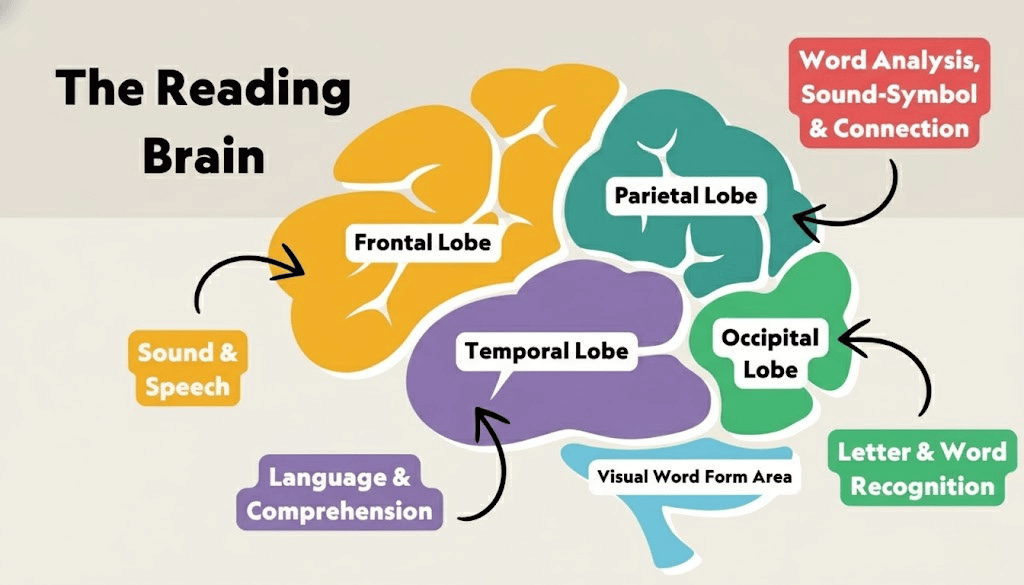
The term "Science of Reading" refers to an interdisciplinary body of research that spans cognitive psychology, developmental psychology, neuroscience, and linguistics. Organizations like The Reading League define it as the evidence from thousands of studies conducted in multiple languages. This research reveals how proficient reading develops, why some learners struggle, and which instructional methods work.
The strength of this evidence comes from its convergence. When findings from different fields point to the same conclusions, that evidence becomes exceptionally powerful. Cognitive psychology explains mental processes like working memory and attention. Neuroscience shows how the brain rewires itself to become a reading brain. Linguistics informs our understanding of language structure, from individual sounds to word parts.
The Science of Reading is not a program, method, or ideology. It is the consensus of what researchers understand about reading acquisition and instruction.
Unlike learning to speak, which humans acquire naturally through exposure, reading is not an innate ability. The human brain did not evolve to read. Writing systems are recent inventions in human history. Learning to read requires explicit instruction to build new neural pathways that connect visual symbols to sounds and meanings.
This fundamental insight drives the Science of Reading. We must intentionally teach children how to decode the complex code of written language. Without direct instruction, many learners are left to guess, struggle, and fall behind. Theories of reading that assume children will naturally absorb reading through exposure have been debunked by cognitive science.
Dr. Hollis Scarborough's Reading Rope (2001) provides one of the most influential frameworks for understanding literacy development. The model visualizes reading as two main strands that must be woven together: Language Comprehension and Word Recognition.
The Language Comprehension strand (shown in red in the image) includes:
The Word Recognition strand (shown in blue in the image) consists of:
These strands start out separate and require explicit instruction. Over time, with practice and skilled teaching, they become increasingly strategic and automatic. When fully developed, they weave together into skilled reading: the fluent execution and coordination of word recognition and text comprehension.
Scarborough's model makes clear that skilled reading requires strength in both strands. Weakness in either area will impede comprehension. A student who can decode every word but lacks vocabulary knowledge will struggle to understand. Similarly, a student with rich oral language comprehension but poor decoding skills cannot access written text independently.
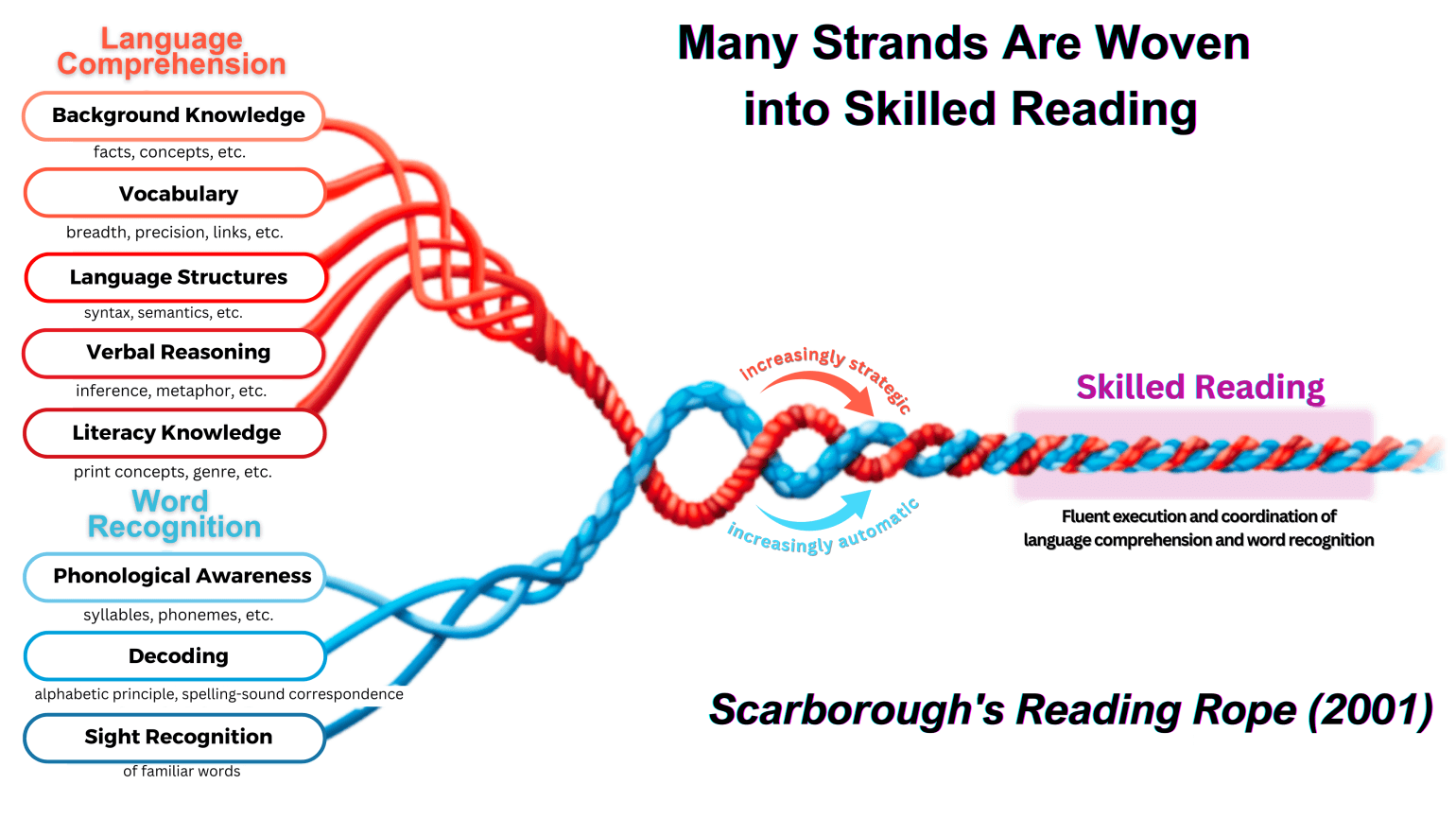
The National Reading Panel identified five essential components of effective reading instruction, commonly known as the Five Pillars of Reading. These pillars form the foundation of evidence-based literacy instruction and align directly with the research in the Science of Reading.
Phonemic awareness is the ability to hear, identify, and manipulate individual sounds (phonemes) in spoken words. This is an auditory skill that happens before children interact with print. Activities include phoneme isolation (identifying the first sound in "cat"), blending sounds together to form words, and segmenting words into their component sounds.
Research shows phonemic awareness is a strong predictor of reading success. Children need to understand that spoken words break down into individual sounds before they can learn how letters represent those sounds.
Phonics instruction teaches the relationships between letters (graphemes) and sounds (phonemes). This is where children learn to map speech to print. Effective phonics is systematic, following a logical sequence, and explicit, with direct teacher instruction.
Students learn letter-sound correspondences, spelling patterns, and how to apply this knowledge to decode unfamiliar words. Systematic phonics instruction has been shown to improve reading accuracy and comprehension more effectively than approaches that do not teach these relationships directly.

Fluency is the ability to read text accurately, at an appropriate rate, and with proper expression (prosody). When decoding becomes automatic, it frees up cognitive resources for comprehension in reading. Fluent readers can focus their mental energy on understanding meaning rather than struggling to identify individual words.
Fluency develops through guided oral reading practice with feedback. Teachers support fluency by providing repeated reading opportunities, modeling expressive reading, and monitoring student progress.
Vocabulary knowledge is a cornerstone of text comprehension. A reader can decode every word in a sentence and still not understand it if they don't know what the words mean. Effective vocabulary instruction includes both direct teaching of specific words and strategies for learning new words independently.
Research shows that vocabulary develops through both direct instruction and wide reading. A knowledge-rich curriculum that builds background knowledge across subjects supports vocabulary growth and reading comprehension.
Reading comprehension is the ultimate goal of literacy instruction. It encompasses the ability to understand, interpret, analyze, and synthesize information from text. Comprehension instruction includes teaching students to use strategies like making predictions, asking questions, monitoring understanding, and summarizing.
Oral language comprehension skills, including verbal reasoning and understanding of language structures, directly support reading comprehension. Programme for International Student Assessment (PISA) results measure real-world reading ability and consistently show that comprehension is influenced by both word recognition skills and broader language comprehension abilities.

Neuroimaging studies reveal what happens in the brain when we learn to read. Skilled readers develop an efficient neural network connecting visual processing areas to language centers. This "reading circuit" is not present at birth. It must be built through effective instruction and practice.
For struggling readers, including the approximately 15% of the U.S. population with dyslexia, these neural circuits are often less developed or inefficient. Neuroscience of learning confirms that instruction aligned with the Science of Reading is specifically designed to forge and strengthen these critical neural connections.
Orthographic mapping is a key process in developing this circuit. This is the mental process readers use to store written words in long-term memory for instant retrieval. It occurs when a reader links a word's pronunciation (phonemes), spelling (graphemes), and meaning together. Through repeated, successful decoding of a word, its letter sequence becomes permanently bonded to its sound and meaning. This is how we build a large sight vocabulary of instantly recognizable words.

The Structural Learning Toolkit provides hands-on, evidence-based resources that support each component of the Science of Reading. Here's how teachers can use these tools to build stronger readers.
Writer's Block can help children visualize and manipulate phonetic patterns. Students arrange blocks to build words, swap individual letters to create new words, and explore spelling patterns tactilely. This concrete approach supports phoneme isolation and blending sounds, making abstract phonics concepts visible and manipulable.
For example, students can create one word using two blocks: place "en" on one block and "p" on another to build "pen." Then swap the "p" block for "h" to create "hen," swap for "t" to make "ten," or use "d" to build "den." This physical manipulation reinforces the alphabetic principle and helps children understand how changing one phoneme changes the word.

The tactile nature of Writer's Block supports decoding instruction. Children physically construct words, seeing how graphemes combine to form complete words. This approach engages multiple senses, supporting students who benefit from multisensory learning.
As students progress, they can build increasingly complex words, exploring digraphs, blends, and more sophisticated spelling patterns. The blocks make decoding a hands-on, engaging process rather than abstract workbook exercises.
The Map It toolkit provides eight graphic organizer templates designed to support text comprehension. Students use structures like Fishbone diagrams to analyze cause and effect, Flow Charts to track sequence, and Venn Diagrams to compare and contrast ideas.
These visual tools help students organize information from texts, making abstract comprehension strategies concrete. By mapping information visually, students build stronger mental models of what they read. This connects directly to reading comprehension strategies in the classroom.

The Thinking Framework provides 30 cognitive prompts organized into five color-coded categories. The Yellow cards focus on explanation and reasoning, perfect for teaching inference skills. When students encounter texts that require reading between the lines, teachers can use prompts like "Explain why..." or "What might happen if..." to guide their thinking.
This explicit approach to teaching inference helps students develop verbal reasoning skills, a critical component of language comprehension in Scarborough's Reading Rope.
Strong readers ask questions before, during, and after reading. The Thinking Framework's Green cards encourage students to identify key information, while Yellow cards (Explain) push them to dig deeper. Teachers can model questioning using these prompts, then gradually release responsibility to students.
This structured approach to questioning in teaching builds metacognitive awareness. Students learn to monitor their own understanding and seek clarification when meaning breaks down.
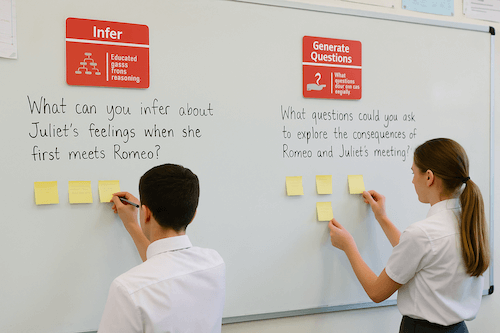
The Say It toolkit provides three types of oracy prompt cards: Starters, Tell-Me-More, and Challengers. These cards structure classroom dialogue and support oral language comprehension. Students use Starter cards to initiate ideas, Tell-Me-More cards to elaborate and extend thinking, and Challenger cards to question and debate.
This structured talk supports verbal reasoning, one of the language comprehension strands in Scarborough's model. The importance of oracy in language development cannot be overstated. Strong oral language skills form the foundation for reading comprehension.
Writer's Block can be used for sentence building and exploring language structures. Students manipulate blocks to construct simple sentences, then add complexity by including conjunctions, adjectives, and adverbs. This physical manipulation helps children understand syntax and grammar in a concrete way.
As students build and rebuild sentences, they engage in exploratory talk, discussing which constructions make sense and why. This develops both language structure understanding and collaborative learning skills.
The Thinking Framework's Orange cards focus specifically on vocabulary. Prompts guide students to identify, define, and use subject-specific vocabulary. Teachers can use these cards during read-alouds, guided reading, or content area instruction to build breadth and precision in word knowledge.
Combined with Writer's Block, students can build words, break them into morphemes, and explore word families. This morphological awareness supports both decoding and vocabulary development.

The Thinking Framework and Map It tools support knowledge building across all subjects. When students use graphic organizers to map concepts in science, history, or art, they build the background knowledge that fuels reading comprehension.
A knowledge-rich curriculum, supported by structured thinking tools, ensures students have the facts, concepts, and experiences they need to understand increasingly complex texts. This addresses the background knowledge strand of Scarborough's Reading Rope, often overlooked in reading instruction focused narrowly on skills.
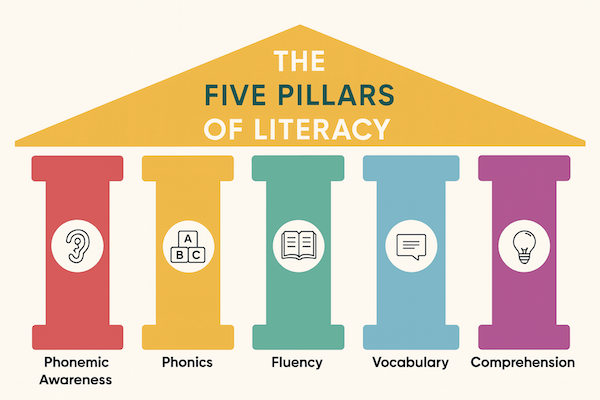
One significant debate has been the contrast between the Science of Reading and "balanced literacy" approaches. While well-intentioned, many balanced literacy practices relied on theories debunked by cognitive science.
The three-cueing system, for example, encourages students to guess words from context or pictures rather than decoding them. Research clearly shows that proficient word recognition is not based on guessing but on precise, letter-by-letter processing that phonics instruction develops. Print concepts matter: children must learn that letters represent sounds in a systematic way.
Leveled reading groups, common in balanced literacy classrooms, often limit students' exposure to complex texts and rich vocabulary. The Science of Reading emphasizes that all students benefit from exposure to grade-level texts with appropriate support.
Structured literacy, by contrast, is explicit, systematic, sequential, and diagnostic. It aligns with decades of research about how children learn to read. Read Write Inc is one example of a structured literacy program used widely in UK schools.
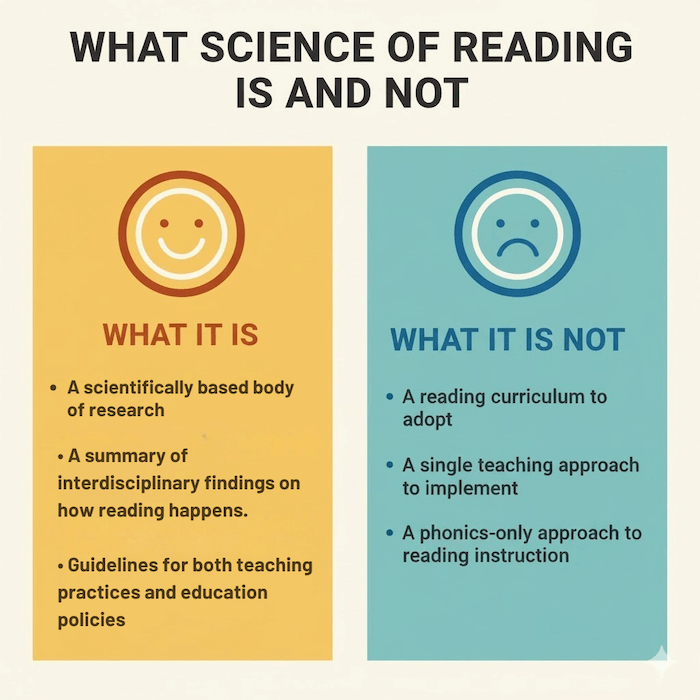
Understanding the research is the first step. The next is translating that knowledge into effective classroom action.
Implementation means adopting structured literacy approaches. This involves dedicating time to foundational skills in early grades, including daily phonemic awareness exercises and systematic phonics lessons. Teachers should use high-quality instructional materials aligned with research and employ assessments to identify students' specific needs.
Professional development in the Science of Reading is essential. Teachers need support to shift from approaches that may feel familiar to methods backed by evidence. Research-informed teaching requires ongoing learning.
Parents are crucial partners in literacy development. They can support reading at home by reading aloud daily to build vocabulary and background knowledge. Engaging in playful sound games, like rhyming and identifying the first sound in words, builds phonological awareness.
Fewer than 1 in 5 young people read daily in their free time. Parental encouragement matters more than ever. Creating a home environment rich in books and conversation supports all strands of Scarborough's Reading Rope.
A core strength of the Science of Reading is its benefit for all students. The explicit, systematic nature of structured literacy is essential for students with reading difficulties like dyslexia. It is demonstrably more effective for English language learners and students from disadvantaged backgrounds.
By providing every child with the foundational skills they need, evidence-based instruction promotes equity. Literacy becomes accessible to all, not just those who find it easy. Resources like quality first teaching ensure all students receive high-quality instruction.

If you want to deepen your understanding of the Science of Reading, these foundational texts provide comprehensive insights into both the research base and practical classroom applications.
1. Artfully Teaching the Science of Reading, Young, Paige, & Rasinski
This book bridges structured reading science with creative teaching. It shows how phonics, fluency, and comprehension can be delivered in engaging, authentic ways without compromising scientific rigor. The authors demonstrate that evidence-based instruction and joyful teaching are not opposites but complementary approaches.
2. Unpacking the Science of Reading Research, G. Rollo & Kellie Picker
This synthesis defines six core constructs: oral language, phonemic awareness, phonics, fluency, vocabulary, and comprehension. The authors explain how these components form the backbone of effective, evidence-based reading development and assessment. This text is particularly useful for educators seeking clarity on how research translates to practice.
3. What Constitutes a Science of Reading Instruction? Timothy Shanahan
Shanahan critiques overreliance on basic cognitive research and urges integrating instructional studies when translating reading science into classroom practice and education policy decisions. This paper, referenced in this guide, provides important nuance about what "research-based" truly means in educational contexts.
4. The Science of Reading: Supports, Critiques, and Questions, Reading Research Quarterly Special Issue
This landmark special issue compiles 26 articles that expand the definition of reading science. It includes motivation, equity, culture, and teacher expertise beyond phonics-focused instruction. This collection acknowledges that the Science of Reading must address the full complexity of literacy development in diverse contexts.
5. Where is Motivation in the Science of Reading? Seth A. Parsons & Joy Dangora Erickson
This paper argues that motivation, a key driver of learning, is underrepresented in reading science discourse. The authors call for integration of motivational frameworks into reading instruction to better engage young readers. This work reminds us that skilled teaching involves more than delivering content; it requires igniting curiosity and persistence.
The challenge of literacy is significant. The Science of Reading provides a powerful, evidence-based roadmap. By focusing on essential components - phonological awareness, phonics, fluency, vocabulary, and comprehension - we can build the strong neural circuits necessary for skilled reading.
This approach moves away from ideology and opinion. It anchors practice in the objective reality of how the human brain learns to read. The ultimate goal is ensuring every child receives instruction aligned with this vast body of research. This requires collective commitment: from educators seeking professional development, from school leaders adopting high-quality curricula, and from parents advocating for evidence-based practices.
By embracing the Science of Reading, we can unlock literacy for millions of students and empower them with the skills they need to succeed.
Reading opens doors and connects children to education, careers, and full participation in society. Yet for many students, this fundamental skill remains frustratingly out of reach. Recent international data reveals a troubling pattern: reading scores have declined across multiple countries in recent years, with significant numbers of students failing to meet basic literacy benchmarks. This decline matters. Research suggests that a substantial proportion of adults worldwide struggle with reading comprehension at levels required for everyday tasks.
The Science of Reading offers a way forward. This body of research, built over five decades, provides clear evidence about how children learn to read and which teaching methods work best. Unlike approaches based on trends or assumptions, the Science of Reading draws on thousands of studies across multiple disciplines and languages. It gives teachers proven strategies to unlock literacy for every student.
Key Takeaways:

The term "Science of Reading" refers to an interdisciplinary body of research that spans cognitive psychology, developmental psychology, neuroscience, and linguistics. Organizations like The Reading League define it as the evidence from thousands of studies conducted in multiple languages. This research reveals how proficient reading develops, why some learners struggle, and which instructional methods work.
The strength of this evidence comes from its convergence. When findings from different fields point to the same conclusions, that evidence becomes exceptionally powerful. Cognitive psychology explains mental processes like working memory and attention. Neuroscience shows how the brain rewires itself to become a reading brain. Linguistics informs our understanding of language structure, from individual sounds to word parts.
The Science of Reading is not a program, method, or ideology. It is the consensus of what researchers understand about reading acquisition and instruction.
Unlike learning to speak, which humans acquire naturally through exposure, reading is not an innate ability. The human brain did not evolve to read. Writing systems are recent inventions in human history. Learning to read requires explicit instruction to build new neural pathways that connect visual symbols to sounds and meanings.
This fundamental insight drives the Science of Reading. We must intentionally teach children how to decode the complex code of written language. Without direct instruction, many learners are left to guess, struggle, and fall behind. Theories of reading that assume children will naturally absorb reading through exposure have been debunked by cognitive science.
Dr. Hollis Scarborough's Reading Rope (2001) provides one of the most influential frameworks for understanding literacy development. The model visualizes reading as two main strands that must be woven together: Language Comprehension and Word Recognition.
The Language Comprehension strand (shown in red in the image) includes:
The Word Recognition strand (shown in blue in the image) consists of:
These strands start out separate and require explicit instruction. Over time, with practice and skilled teaching, they become increasingly strategic and automatic. When fully developed, they weave together into skilled reading: the fluent execution and coordination of word recognition and text comprehension.
Scarborough's model makes clear that skilled reading requires strength in both strands. Weakness in either area will impede comprehension. A student who can decode every word but lacks vocabulary knowledge will struggle to understand. Similarly, a student with rich oral language comprehension but poor decoding skills cannot access written text independently.

The National Reading Panel identified five essential components of effective reading instruction, commonly known as the Five Pillars of Reading. These pillars form the foundation of evidence-based literacy instruction and align directly with the research in the Science of Reading.
Phonemic awareness is the ability to hear, identify, and manipulate individual sounds (phonemes) in spoken words. This is an auditory skill that happens before children interact with print. Activities include phoneme isolation (identifying the first sound in "cat"), blending sounds together to form words, and segmenting words into their component sounds.
Research shows phonemic awareness is a strong predictor of reading success. Children need to understand that spoken words break down into individual sounds before they can learn how letters represent those sounds.
Phonics instruction teaches the relationships between letters (graphemes) and sounds (phonemes). This is where children learn to map speech to print. Effective phonics is systematic, following a logical sequence, and explicit, with direct teacher instruction.
Students learn letter-sound correspondences, spelling patterns, and how to apply this knowledge to decode unfamiliar words. Systematic phonics instruction has been shown to improve reading accuracy and comprehension more effectively than approaches that do not teach these relationships directly.

Fluency is the ability to read text accurately, at an appropriate rate, and with proper expression (prosody). When decoding becomes automatic, it frees up cognitive resources for comprehension in reading. Fluent readers can focus their mental energy on understanding meaning rather than struggling to identify individual words.
Fluency develops through guided oral reading practice with feedback. Teachers support fluency by providing repeated reading opportunities, modeling expressive reading, and monitoring student progress.
Vocabulary knowledge is a cornerstone of text comprehension. A reader can decode every word in a sentence and still not understand it if they don't know what the words mean. Effective vocabulary instruction includes both direct teaching of specific words and strategies for learning new words independently.
Research shows that vocabulary develops through both direct instruction and wide reading. A knowledge-rich curriculum that builds background knowledge across subjects supports vocabulary growth and reading comprehension.
Reading comprehension is the ultimate goal of literacy instruction. It encompasses the ability to understand, interpret, analyze, and synthesize information from text. Comprehension instruction includes teaching students to use strategies like making predictions, asking questions, monitoring understanding, and summarizing.
Oral language comprehension skills, including verbal reasoning and understanding of language structures, directly support reading comprehension. Programme for International Student Assessment (PISA) results measure real-world reading ability and consistently show that comprehension is influenced by both word recognition skills and broader language comprehension abilities.

Neuroimaging studies reveal what happens in the brain when we learn to read. Skilled readers develop an efficient neural network connecting visual processing areas to language centers. This "reading circuit" is not present at birth. It must be built through effective instruction and practice.
For struggling readers, including the approximately 15% of the U.S. population with dyslexia, these neural circuits are often less developed or inefficient. Neuroscience of learning confirms that instruction aligned with the Science of Reading is specifically designed to forge and strengthen these critical neural connections.
Orthographic mapping is a key process in developing this circuit. This is the mental process readers use to store written words in long-term memory for instant retrieval. It occurs when a reader links a word's pronunciation (phonemes), spelling (graphemes), and meaning together. Through repeated, successful decoding of a word, its letter sequence becomes permanently bonded to its sound and meaning. This is how we build a large sight vocabulary of instantly recognizable words.

The Structural Learning Toolkit provides hands-on, evidence-based resources that support each component of the Science of Reading. Here's how teachers can use these tools to build stronger readers.
Writer's Block can help children visualize and manipulate phonetic patterns. Students arrange blocks to build words, swap individual letters to create new words, and explore spelling patterns tactilely. This concrete approach supports phoneme isolation and blending sounds, making abstract phonics concepts visible and manipulable.
For example, students can create one word using two blocks: place "en" on one block and "p" on another to build "pen." Then swap the "p" block for "h" to create "hen," swap for "t" to make "ten," or use "d" to build "den." This physical manipulation reinforces the alphabetic principle and helps children understand how changing one phoneme changes the word.

The tactile nature of Writer's Block supports decoding instruction. Children physically construct words, seeing how graphemes combine to form complete words. This approach engages multiple senses, supporting students who benefit from multisensory learning.
As students progress, they can build increasingly complex words, exploring digraphs, blends, and more sophisticated spelling patterns. The blocks make decoding a hands-on, engaging process rather than abstract workbook exercises.
The Map It toolkit provides eight graphic organizer templates designed to support text comprehension. Students use structures like Fishbone diagrams to analyze cause and effect, Flow Charts to track sequence, and Venn Diagrams to compare and contrast ideas.
These visual tools help students organize information from texts, making abstract comprehension strategies concrete. By mapping information visually, students build stronger mental models of what they read. This connects directly to reading comprehension strategies in the classroom.

The Thinking Framework provides 30 cognitive prompts organized into five color-coded categories. The Yellow cards focus on explanation and reasoning, perfect for teaching inference skills. When students encounter texts that require reading between the lines, teachers can use prompts like "Explain why..." or "What might happen if..." to guide their thinking.
This explicit approach to teaching inference helps students develop verbal reasoning skills, a critical component of language comprehension in Scarborough's Reading Rope.
Strong readers ask questions before, during, and after reading. The Thinking Framework's Green cards encourage students to identify key information, while Yellow cards (Explain) push them to dig deeper. Teachers can model questioning using these prompts, then gradually release responsibility to students.
This structured approach to questioning in teaching builds metacognitive awareness. Students learn to monitor their own understanding and seek clarification when meaning breaks down.

The Say It toolkit provides three types of oracy prompt cards: Starters, Tell-Me-More, and Challengers. These cards structure classroom dialogue and support oral language comprehension. Students use Starter cards to initiate ideas, Tell-Me-More cards to elaborate and extend thinking, and Challenger cards to question and debate.
This structured talk supports verbal reasoning, one of the language comprehension strands in Scarborough's model. The importance of oracy in language development cannot be overstated. Strong oral language skills form the foundation for reading comprehension.
Writer's Block can be used for sentence building and exploring language structures. Students manipulate blocks to construct simple sentences, then add complexity by including conjunctions, adjectives, and adverbs. This physical manipulation helps children understand syntax and grammar in a concrete way.
As students build and rebuild sentences, they engage in exploratory talk, discussing which constructions make sense and why. This develops both language structure understanding and collaborative learning skills.
The Thinking Framework's Orange cards focus specifically on vocabulary. Prompts guide students to identify, define, and use subject-specific vocabulary. Teachers can use these cards during read-alouds, guided reading, or content area instruction to build breadth and precision in word knowledge.
Combined with Writer's Block, students can build words, break them into morphemes, and explore word families. This morphological awareness supports both decoding and vocabulary development.

The Thinking Framework and Map It tools support knowledge building across all subjects. When students use graphic organizers to map concepts in science, history, or art, they build the background knowledge that fuels reading comprehension.
A knowledge-rich curriculum, supported by structured thinking tools, ensures students have the facts, concepts, and experiences they need to understand increasingly complex texts. This addresses the background knowledge strand of Scarborough's Reading Rope, often overlooked in reading instruction focused narrowly on skills.

One significant debate has been the contrast between the Science of Reading and "balanced literacy" approaches. While well-intentioned, many balanced literacy practices relied on theories debunked by cognitive science.
The three-cueing system, for example, encourages students to guess words from context or pictures rather than decoding them. Research clearly shows that proficient word recognition is not based on guessing but on precise, letter-by-letter processing that phonics instruction develops. Print concepts matter: children must learn that letters represent sounds in a systematic way.
Leveled reading groups, common in balanced literacy classrooms, often limit students' exposure to complex texts and rich vocabulary. The Science of Reading emphasizes that all students benefit from exposure to grade-level texts with appropriate support.
Structured literacy, by contrast, is explicit, systematic, sequential, and diagnostic. It aligns with decades of research about how children learn to read. Read Write Inc is one example of a structured literacy program used widely in UK schools.

Understanding the research is the first step. The next is translating that knowledge into effective classroom action.
Implementation means adopting structured literacy approaches. This involves dedicating time to foundational skills in early grades, including daily phonemic awareness exercises and systematic phonics lessons. Teachers should use high-quality instructional materials aligned with research and employ assessments to identify students' specific needs.
Professional development in the Science of Reading is essential. Teachers need support to shift from approaches that may feel familiar to methods backed by evidence. Research-informed teaching requires ongoing learning.
Parents are crucial partners in literacy development. They can support reading at home by reading aloud daily to build vocabulary and background knowledge. Engaging in playful sound games, like rhyming and identifying the first sound in words, builds phonological awareness.
Fewer than 1 in 5 young people read daily in their free time. Parental encouragement matters more than ever. Creating a home environment rich in books and conversation supports all strands of Scarborough's Reading Rope.
A core strength of the Science of Reading is its benefit for all students. The explicit, systematic nature of structured literacy is essential for students with reading difficulties like dyslexia. It is demonstrably more effective for English language learners and students from disadvantaged backgrounds.
By providing every child with the foundational skills they need, evidence-based instruction promotes equity. Literacy becomes accessible to all, not just those who find it easy. Resources like quality first teaching ensure all students receive high-quality instruction.

If you want to deepen your understanding of the Science of Reading, these foundational texts provide comprehensive insights into both the research base and practical classroom applications.
1. Artfully Teaching the Science of Reading, Young, Paige, & Rasinski
This book bridges structured reading science with creative teaching. It shows how phonics, fluency, and comprehension can be delivered in engaging, authentic ways without compromising scientific rigor. The authors demonstrate that evidence-based instruction and joyful teaching are not opposites but complementary approaches.
2. Unpacking the Science of Reading Research, G. Rollo & Kellie Picker
This synthesis defines six core constructs: oral language, phonemic awareness, phonics, fluency, vocabulary, and comprehension. The authors explain how these components form the backbone of effective, evidence-based reading development and assessment. This text is particularly useful for educators seeking clarity on how research translates to practice.
3. What Constitutes a Science of Reading Instruction? Timothy Shanahan
Shanahan critiques overreliance on basic cognitive research and urges integrating instructional studies when translating reading science into classroom practice and education policy decisions. This paper, referenced in this guide, provides important nuance about what "research-based" truly means in educational contexts.
4. The Science of Reading: Supports, Critiques, and Questions, Reading Research Quarterly Special Issue
This landmark special issue compiles 26 articles that expand the definition of reading science. It includes motivation, equity, culture, and teacher expertise beyond phonics-focused instruction. This collection acknowledges that the Science of Reading must address the full complexity of literacy development in diverse contexts.
5. Where is Motivation in the Science of Reading? Seth A. Parsons & Joy Dangora Erickson
This paper argues that motivation, a key driver of learning, is underrepresented in reading science discourse. The authors call for integration of motivational frameworks into reading instruction to better engage young readers. This work reminds us that skilled teaching involves more than delivering content; it requires igniting curiosity and persistence.
The challenge of literacy is significant. The Science of Reading provides a powerful, evidence-based roadmap. By focusing on essential components - phonological awareness, phonics, fluency, vocabulary, and comprehension - we can build the strong neural circuits necessary for skilled reading.
This approach moves away from ideology and opinion. It anchors practice in the objective reality of how the human brain learns to read. The ultimate goal is ensuring every child receives instruction aligned with this vast body of research. This requires collective commitment: from educators seeking professional development, from school leaders adopting high-quality curricula, and from parents advocating for evidence-based practices.
By embracing the Science of Reading, we can unlock literacy for millions of students and empower them with the skills they need to succeed.